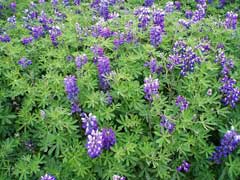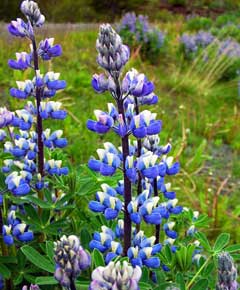 |
|
http://de.wikipedia.org/wiki/Benutzer:Jutta234 |
 |
| http://de.wikipedia.org/wiki/Benutzer:Jutta234 |
Translate this page:
Summary
Physical Characteristics

 Lupinus nootkatensis is a PERENNIAL growing to 0.7 m (2ft 4in).
Lupinus nootkatensis is a PERENNIAL growing to 0.7 m (2ft 4in).
See above for USDA hardiness. It is hardy to UK zone 4. The species is hermaphrodite (has both male and female organs) and is pollinated by Bees.
It can fix Nitrogen.
Suitable for: light (sandy), medium (loamy) and heavy (clay) soils and prefers well-drained soil. Suitable pH: mildly acid, neutral and basic (mildly alkaline) soils. It cannot grow in the shade. It prefers moist soil.
UK Hardiness Map
US Hardiness Map
Synonyms
Plant Habitats
Cultivated Beds;
Edible Uses
Edible Parts: Root Seed Seedpod
Edible Uses:
Seed - cooked[105]. Used as a protein-rich vegetable or savoury dish in any of the ways that cooked beans are used, they can also be roasted or ground into a powder. If the seed is bitter this is due to the presence of toxic alkaloids and the seed should be thoroughly leached before being cooked[2, 105]. Root - raw or cooked[256, 257]. Peeled and then eaten raw or boiled[257]. The roots are harvested in the spring and are then roasted before being eaten[256]. The roasted root can be dried, ground into a flour and then stored for later use. The raw root should not be eaten since they contain toxic alkaloids and will cause a drunken-like state if eaten in excess, but the cooked root is safe to eat[256, 257]. Seedpods - cooked[105].
References More on Edible Uses
Medicinal Uses
Plants For A Future can not take any responsibility for any adverse effects from the use of plants. Always seek advice from a professional before using a plant medicinally.
None known
References More on Medicinal Uses
The Bookshop: Edible Plant Books
Our Latest books on Perennial Plants For Food Forests and Permaculture Gardens in paperback or digital formats.

Edible Tropical Plants
Food Forest Plants for Hotter Conditions: 250+ Plants For Tropical Food Forests & Permaculture Gardens.
More

Edible Temperate Plants
Plants for Your Food Forest: 500 Plants for Temperate Food Forests & Permaculture Gardens.
More

More Books
PFAF have eight books available in paperback and digital formats. Browse the shop for more information.
Shop Now
Other Uses
References More on Other Uses
Cultivation details
An easily grown plant, succeeding in any moderately good soil in a sunny position[200]. This species is very susceptible to slug damage, the plant has been cultivated as an ornamental, but has virtually died out in the garden though it grows well in the wild in Scotland[187]. Closely related to L. perennis[200] and possibly no more than a sub-species of it[50], the uses listed below are for L. perennis but it is assumed that they also apply to this species[K]. This species has a symbiotic relationship with certain soil bacteria, these bacteria form nodules on the roots and fix atmospheric nitrogen. Some of this nitrogen is utilized by the growing plant but some can also be used by other plants growing nearby[200].
References Carbon Farming Information and Carbon Sequestration Information
Temperature Converter
Type a value in the Celsius field to convert the value to Fahrenheit:
Fahrenheit:
The PFAF Bookshop
Plants For A Future have a number of books available in paperback and digital form. Book titles include Edible Plants, Edible Perennials, Edible Trees,Edible Shrubs, Woodland Gardening, and Temperate Food Forest Plants. Our new book is Food Forest Plants For Hotter Conditions (Tropical and Sub-Tropical).
Shop Now
Plant Propagation
Pre-soak the seed for 24 hours in warm water and then sow in early spring in a greenhouse. Germination should take place within a couple of weeks. When they are large enough to handle, prick the seedlings out into individual pots and plant them out in early summer. It should also be possible to sow the seed outdoors in situ in the middle of spring. It might be necessary to protect this sowing from mice. Division in early March[1]. Difficult. Basal cuttings in April[1]. Harvest the shoots when they are about 10cm long with plenty of underground stem. Pot them up into individual pots and keep them in light shade in a cold frame or greenhouse until they are rooting well. Plant them out in the summer.
Other Names
If available other names are mentioned here
Native Range
NORTHERN AMERICA: Canada (Yukon (southwest), British Columbia (west)), United States (Alaska (south))
Weed Potential
Right plant wrong place. We are currently updating this section.
Please note that a plant may be invasive in one area but may not in your area so it's worth checking.
Conservation Status
IUCN Red List of Threatened Plants Status :

Growth: S = slow M = medium F = fast. Soil: L = light (sandy) M = medium H = heavy (clay). pH: A = acid N = neutral B = basic (alkaline). Shade: F = full shade S = semi-shade N = no shade. Moisture: D = dry M = Moist We = wet Wa = water.
Now available:
Food Forest Plants for Mediterranean Conditions
350+ Perennial Plants For Mediterranean and Drier Food Forests and Permaculture Gardens.
[Paperback and eBook]
This is the third in Plants For A Future's series of plant guides for food forests tailored to
specific climate zones. Following volumes on temperate and tropical ecosystems, this book focuses
on species suited to Mediterranean conditions—regions with hot, dry summers and cool, wet winters,
often facing the added challenge of climate change.
Read More
Expert comment
Author
Donn. ex Sims.
Botanical References
43200
Links / References
For a list of references used on this page please go here
Readers comment
| Add a comment |
|
If you have important information about this plant that may help other users please add a comment or link below. Only comments or links that are felt to be directly relevant to a plant will be included. If you think a comment/link or information contained on this page is inaccurate or misleading we would welcome your feedback at [email protected]. If you have questions about a plant please use the Forum on this website as we do not have the resources to answer questions ourselves.
* Please note: the comments by website users are not necessarily those held by PFAF and may give misleading or inaccurate information.
To leave a comment please Register or login here All comments need to be approved so will not appear immediately.
|
Subject : Lupinus nootkatensis
|
|
|
|